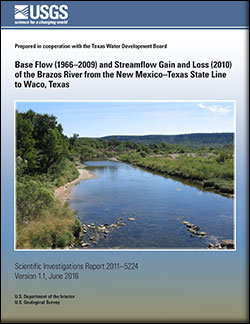 Abstract Abstract
During 2010–11, the U.S. Geological Survey (USGS), in cooperation with the Texas Water Development Board, used hydrograph separation to quantify historical base flow at 11 USGS streamflow-gaging stations between water years 1966–2009 and streamflow gains and losses from two sets of synoptic measurements of streamflow and specific conductance (the first in June 2010, followed by another set in October 2010) in the upper Brazos River Basin from the New Mexico–Texas State line to Waco, Texas. The following subbasins compose the study area: Salt Fork Brazos River Basin, Double Mountain Fork Brazos River Basin, Clear Fork Brazos River Basin, North Bosque River Basin, and the Brazos River Basin (main stem) (including its tributaries). Base-flow analysis was done using historical streamflow data from 11 USGS streamflow-gaging stations in the upper Brazos River Basin to compute yearly base-flow indexes (base flow divided by total streamflow) for each station. The base-flow index was used to indicate the fraction of flow consisting of base flow on an annual basis for the period of record evaluated at each streamflow-gaging station. At nine stations there were long-term streamflow data from water years 1966–2009 (October 1965 through September 2009); at two stations slightly shorter periods of record (water years 1967–2009 and 1969–2009) were available. The median base-flow indexes were 0.16 and 0.15 at USGS streamflow-gaging stations 08082000 Salt Fork Brazos River near Aspermont, Tex., and 08080500 Double Mountain Fork Brazos River near Aspermont, Tex., respectively. The amount of the total streamflow consisting of base flow was larger at sites in the Clear Fork Brazos River Basin compared to sites in the Salt Fork Brazos River Basin or Double Mountain Fork Brazos River Basin; at USGS streamflow-gaging stations 08084000 Clear Fork Brazos River at Nugent, Tex., and at 08085500 Clear Fork Brazos River at Fort Griffin, Tex., the median base-flow indexes were 0.28 and 0.23, respectively. The largest median base-flow index for any station was 0.35 at USGS streamflow-gaging station 08091500 Paluxy River at Glen Rose, Tex. The second largest base-flow index was 0.30 at USGS streamflow-gaging station 08095000 North Bosque River near Clifton, Tex. Median base-flow indexes on the main stem of the Brazos River upstream from Possum Kingdom Lake were 0.22 at USGS streamflow-gaging station 08082500 Brazos River at Seymour, Tex., and 0.24 at USGS streamflow-gaging station 08088000 Brazos River near South Bend, Tex. The base-flow indexes for stations between Possum Kingdom Lake and Lake Granbury were 0.19 and 0.27 at USGS streamflow-gaging stations 08089000 Brazos River near Palo Pinto, Tex., and 08090800 Brazos River near Dennis, Tex., respectively. A median base-flow index of 0.19 was also measured at USGS streamflow-gaging station 08091000 Brazos River near Glen Rose, Tex., located between Lake Granbury and Lake Whitney. A Mann-Kendall trend analysis test was performed on annual base-flow index values from each of the 11 streamflow records that were analyzed. Upward trends in base-flow index values indicating increasing flows during the study period were found for USGS streamflow-gaging stations 08080500 Double Mountain Fork Brazos River near Aspermont, Tex., 08089000 Brazos River near Palo Pinto, Tex., and 08090800 Brazos River near Dennis, Tex. Flows at these three streamflow-gaging stations are regulated by reservoir releases, and additional analyses are needed before these streamflow trends can be characterized as indicative of changes in base flow over time.
Streamflow was measured at 66 sites from June 6–9, 2010, and at 68 sites from October 16–19, 2010, to identify reaches in the upper Brazos River Basin that were gaining or losing streamflow. Gaining reaches were identified in each of the five subbasins. The gaining reach in the Salt Fork Brazos River Basin began at USGS streamflow-gaging station 08080940 Salt Fork Brazos River at State Highway 208 near Clairemont, Tex. (site SF–6), upstream from where Duck Creek flows into the Salt Fork Brazos River and continued downstream past USGS streamflow-gaging station 08082000 Salt Fork Brazos River near Aspermont, Tex. (site SF–9), to the outlet of the basin. In the Double Mountain Fork Brazos River Basin, a gaining reach from near Post, Tex., downstream to the outlet of the basin was identified. Two gaining reaches were identified in the Clear Fork Brazos River Basin—one from near Roby, Tex., downstream to near Noodle, Tex., and second from Hawley, Tex., downstream to Nugent, Tex. Most of the North Bosque River was characterized as gaining streamflow. Streamflow gains were identified in the main stem of the Brazos River from where the Brazos River main stem forms at the confluence of the Salt Fork Brazos River and Double Mountain Fork Brazos River near Knox City, Tex., downstream to near Seymour, Tex.
|
This report is presented in Portable Document Format (PDF); the latest version of Adobe Reader or similar software is required to view it. Download the latest version of Adobe Reader, free of charge. |